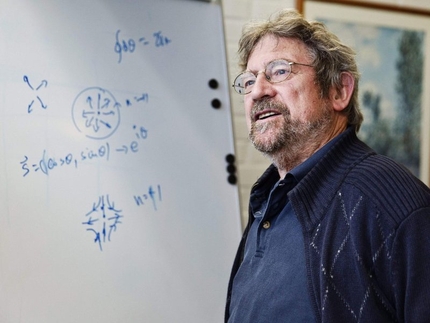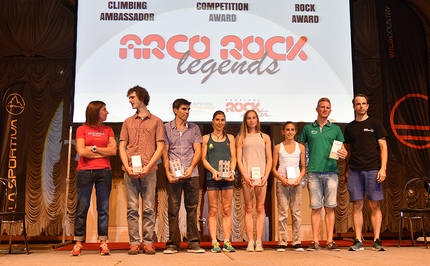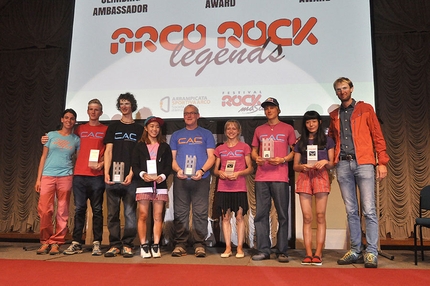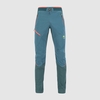Mike Kosterlitz, Nobel Prize in Physics 2016, awarded Climbing Ambassador at the Arco climbing Oscars

 1 / 7
1 / 7 Ken Wilson
Ken Wilson
“My climbing years were very important to me and it is very special to be honored for my early climbing exploits.” These are the words Nobel prize winner Mike Kosterlitz chose when he heard the news that he had been selected to receive the Climbing Ambassador prize of the Arco Rock Legends 2017 Awards that take place, as every year, doing the Rock Master champions climbing competition. This honour is naturally shared by the city of Arco and the entire Garda Trentino region which, on Friday 25 August during the 12th edition of the climbing Oscars, will witness the 74-year-old professor of Physics from Brown University (Providence, RI, USA) and winner of the 2016 Nobel Prize in physics receive the Climbing Ambassador by Dryarn® di Aquafil award. Every year the SSD Arrampicata Sportiva Arco association awards this prize to “those who, through their passion, energy and vision have guided and influenced the development of this sport. John Michael Kosterlitz most certainly was and still is a source of inspiration for all climbers. So much so that within the climbing community he is better known for his antics on rock that for his academic achievements and this Nobel Prize in Physics. So much so that his name is legendary, mythical even, among all climbers.
Mike Kosterlitz was born in 1943 in Aberdeen, Scotland, the son of Jews who fled from Nazi Germany in 1934. His father, Hans Walter Kosterlitz, was one of the pioneers of biochemistry. Mike arrived in Italy in autumn 1969 as a fellow at the Theoretical Physics Institute of the University of Turin, after having graduated from the University of Cambridge and having gained a PhD at the University of Oxford. At that time he was already an important climber with standout ascents such as the first repeat of the famous American Direct up Les Dru (Mont Blanc), and the first ascent of the difficult British route up the North Face of Pizzo Badile. And it was in Italy that he became “the” Kosterlitz which has become a symbol for generations of climbers, thanks also to a chance encounter with Gian Carlo Grassi, Gian Piero Motti, Ugo Manera and the others in that group of Turin climbers who were changing the face of climbing in the early 1970’s.
They introduced him to the Orco Valley and all its unclimbed rock. He on the other hand brought his no-compromise, pure style of British climbing. Together they forged gems such as Pesce d’aprile at Torre di Aimonin or Sole nascente on Caporal. At the time, for that era, these climbs were authentic visions that anticipated the future. As was what would later become known to absolutely everyone as “Fessura Kosterlitz”, the Kosterlitz crack. That 7-meter-high splitter which was first ascended by the future Nobel Prize in Physics on a boulder in the Orco Valley and which immediately became the symbol not only of “crack climbing" but also one of the first examples of what much later would be described as "bouldering". This crack was such a powerful and important achievement that when the "Kosterlitz" boulder risked being destroyed due to a new tunnel, the climbing community protested vehemently and managed to stop this climbing monument from being destroyed for good. This, too, is something rare and almost unique.
After those early Italian years in the 70’s, Mike Kosterlitz moved to the United States to work at Cornell University, Princeton University, Bell Telephone Laboratories and Harvard University. He has been professor at Brown University in Providence, Rhode Island since 1982. In the meantime, serious illness prevented Kosterlitz from climbing any longer. Last year came the Nobel Prize in Physics (also awarded to David Thouless and Duncan Haldane) for “theoretical discoveries of topological phase transitions and topological phases of matter." This mathematical concept and study is completely incomprehensible to most. Similarly, Kosterlitz’s climbs are probably just as incomprehensible to the wider audience. What is certain however is that those who awarded the Nobel prize managed to see and comprehend how important these studies are for us all, for our future. At the same time, the prize that will be awarded in Arco on August 25th indicates something that climbers have already known for a long time: Kosterlitz has always been one of the great climbing ambassadors and a constant source of inspiration.
On closer inspection, perhaps these two aspects aren’t so diverse. Also because Kosterlitz himself stated that the ideas that eventually led to his Nobel prize came about during his climbing times. It’s evocative to imagine that, while training on his famous traverse at Cambridge University or while climbing that famous crack in Valle dell’Orco, he was combining those impossible laws of physics with climbing’s impossible balance acts. That is also why Kosterlitz receives the Climbing Ambassador award “For having taught and demonstrated once again that great loves - like the one he has for climbing - are fundamental for our lives and for our development."
di Vinicio Stefanello
The date is August 25, 2017 at Arco for the Arco Rock Legends awards ceremony at 21:00. In addition to the Climbing Ambassador by Dryarn® di Aquafil prize, two further prizes will be awarded: the Wild Country Rock Award for the best sport climber at the crags or in bouldering, and the La Sportiva Competition Award for last season’s best competition athlete.
HALL OF FAME CLIMBING AMBASSADOR AWARD
Jerry Moffatt, Maurizio ‘Manolo' Zanolla, Luisa Iovane, Lynn Hill, François Legrand, Yuji Hirayama, Stefan Glowacz, the Paraclimbing movement, Mauro Corona, John Ellison (founder of CAC – Climbers Against Cancer), IFSC FInternational Federation of Sport Climbing



 Copia link
Copia link







 See all photos
See all photos


























